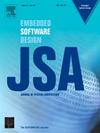Databelt: A continuous data path for serverless workflows in the 3D compute continuum
IF 4.1
2区 计算机科学
Q1 COMPUTER SCIENCE, HARDWARE & ARCHITECTURE
引用次数: 0
Abstract
Serverless computing allows for dynamic and flexible execution of FaaS functions while simplifying infrastructure management. Typically, serverless functions rely on remote storage services for managing state, which can result in increased latency and network communication overhead. In a dynamic environment such as the 3D (Edge–Cloud–Space) Compute Continuum, serverless functions face additional challenges due to frequent changes in network topology. As satellites move in and out of the range of ground stations, functions must make multiple hops to access cloud services, leading to high-latency state access and unnecessary data transfers. In this paper, we present Databelt, a state management framework for serverless workflows designed for the dynamic environment of the 3D Compute Continuum. Databelt introduces an SLO-aware state propagation mechanism that enables the function state to move continuously in orbit. Databelt proactively offloads function states to the most suitable node, such that when functions execute, the data is already present on the execution node or nearby, thus minimizing state access latency and reducing the number of network hops. Additionally, Databelt introduces a function state fusion mechanism that abstracts state management for functions sharing the same serverless runtime. When functions are fused, Databelt seamlessly retrieves their state as a group, reducing redundant network and storage operations and improving overall workflow efficiency. Our experimental results show that Databelt reduces workflow execution time by up to 66% and increases throughput by 50% compared to the baselines. Furthermore, our results show that Databelt function state fusion reduces storage operations latency by up to 20%, by reducing repetitive storage requests for functions within the same runtime, ensuring efficient execution of serverless workflows in highly dynamic network environments such as the 3D Continuum.
Databelt:用于3D计算连续体中的无服务器工作流的连续数据路径
无服务器计算允许动态和灵活地执行FaaS功能,同时简化基础设施管理。通常,无服务器功能依赖于远程存储服务来管理状态,这可能会增加延迟和网络通信开销。在诸如3D(边缘云空间)计算连续体这样的动态环境中,由于网络拓扑结构的频繁变化,无服务器功能面临着额外的挑战。随着卫星进出地面站的范围,功能必须进行多次跳转才能访问云服务,从而导致高延迟状态访问和不必要的数据传输。在本文中,我们提出了Databelt,一个为3D计算连续体的动态环境设计的无服务器工作流的状态管理框架。Databelt引入了一种慢速感知状态传播机制,使函数状态能够在轨道上连续移动。Databelt主动将函数状态卸载到最合适的节点,这样当函数执行时,数据已经存在于执行节点上或附近,从而最小化状态访问延迟并减少网络跳数。此外,Databelt引入了一种功能状态融合机制,该机制为共享相同无服务器运行时的功能抽象了状态管理。当功能融合时,Databelt无缝地检索它们作为一个组的状态,减少冗余的网络和存储操作,提高整体工作流程效率。我们的实验结果表明,与基线相比,Databelt将工作流执行时间缩短了66%,吞吐量提高了50%。此外,我们的研究结果表明,Databelt功能状态融合通过减少相同运行时内对功能的重复存储请求,确保在高动态网络环境(如3D Continuum)中有效执行无服务器工作流程,可将存储操作延迟减少多达20%。
本文章由计算机程序翻译,如有差异,请以英文原文为准。
求助全文
约1分钟内获得全文
求助全文
来源期刊

Journal of Systems Architecture
工程技术-计算机:硬件
CiteScore
8.70
自引率
15.60%
发文量
226
审稿时长
46 days
期刊介绍:
The Journal of Systems Architecture: Embedded Software Design (JSA) is a journal covering all design and architectural aspects related to embedded systems and software. It ranges from the microarchitecture level via the system software level up to the application-specific architecture level. Aspects such as real-time systems, operating systems, FPGA programming, programming languages, communications (limited to analysis and the software stack), mobile systems, parallel and distributed architectures as well as additional subjects in the computer and system architecture area will fall within the scope of this journal. Technology will not be a main focus, but its use and relevance to particular designs will be. Case studies are welcome but must contribute more than just a design for a particular piece of software.
Design automation of such systems including methodologies, techniques and tools for their design as well as novel designs of software components fall within the scope of this journal. Novel applications that use embedded systems are also central in this journal. While hardware is not a part of this journal hardware/software co-design methods that consider interplay between software and hardware components with and emphasis on software are also relevant here.
 求助内容:
求助内容: 应助结果提醒方式:
应助结果提醒方式:


